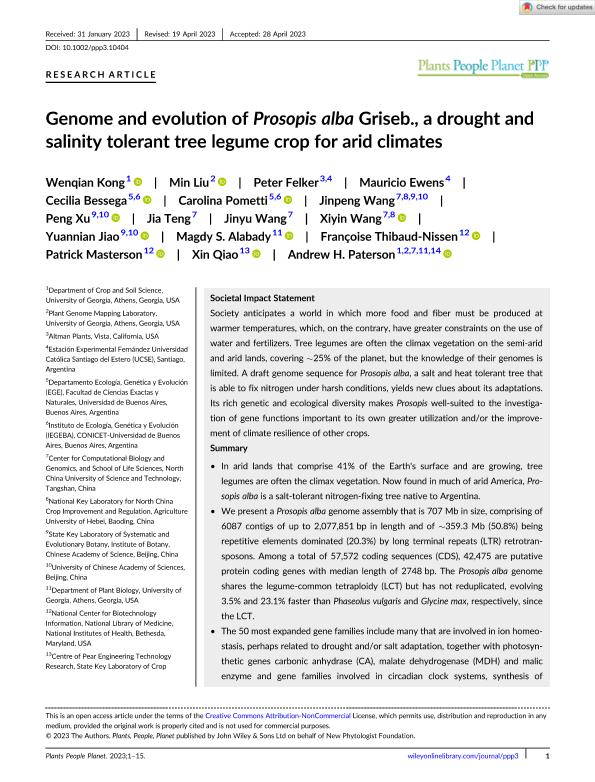Artículo
Genome and evolution of Prosopis alba Griseb., a drought and salinity tolerant tree legume crop for arid climates
Kong, Wenqian; Liu, Min; Felker, Peter; Ewens, Mauricio; Bessega, Cecilia Fabiana ; Pometti, Carolina Luciana
; Pometti, Carolina Luciana ; Wang, Jinpeng; Xu, Peng; Teng, Jia; Wang, Jinyu; Wang, Xiyin; Jiao, Yuannian; Alabady, Magdy S.; Thibaud Nissen, Françoise; Masterson, Patrick; Qiao, Xin; Paterson, Andrew H.
; Wang, Jinpeng; Xu, Peng; Teng, Jia; Wang, Jinyu; Wang, Xiyin; Jiao, Yuannian; Alabady, Magdy S.; Thibaud Nissen, Françoise; Masterson, Patrick; Qiao, Xin; Paterson, Andrew H.
 ; Pometti, Carolina Luciana
; Pometti, Carolina Luciana ; Wang, Jinpeng; Xu, Peng; Teng, Jia; Wang, Jinyu; Wang, Xiyin; Jiao, Yuannian; Alabady, Magdy S.; Thibaud Nissen, Françoise; Masterson, Patrick; Qiao, Xin; Paterson, Andrew H.
; Wang, Jinpeng; Xu, Peng; Teng, Jia; Wang, Jinyu; Wang, Xiyin; Jiao, Yuannian; Alabady, Magdy S.; Thibaud Nissen, Françoise; Masterson, Patrick; Qiao, Xin; Paterson, Andrew H.
Fecha de publicación:
11/2023
Editorial:
John Wiley & Sons
Revista:
Plants People Planet
ISSN:
2572-2611
e-ISSN:
2572-2611
Idioma:
Inglés
Tipo de recurso:
Artículo publicado
Clasificación temática:
Resumen
Societal Impact Statement: Society anticipates a world in which more food and fiber must be produced at warmer temperatures, which, on the contrary, have greater constraints on the use of water and fertilizers. Tree legumes are often the climax vegetation on the semi-arid and arid lands, covering ~25% of the planet, but the knowledge of their genomes is limited. A draft genome sequence for Prosopis alba, a salt and heat tolerant tree that is able to fix nitrogen under harsh conditions, yields new clues about its adaptations. Its rich genetic and ecological diversity makes Prosopis well-suited to the investigation of gene functions important to its own greater utilization and/or the improvement of climate resilience of other crops. Summary: In arid lands that comprise 41% of the Earth's surface and are growing, tree legumes are often the climax vegetation. Now found in much of arid America, Prosopis alba is a salt-tolerant nitrogen-fixing tree native to Argentina. We present a Prosopis alba genome assembly that is 707 Mb in size, comprising of 6087 contigs of up to 2,077,851 bp in length and of ~359.3 Mb (50.8%) being repetitive elements dominated (20.3%) by long terminal repeats (LTR) retrotransposons. Among a total of 57,572 coding sequences (CDS), 42,475 are putative protein coding genes with median length of 2748 bp. The Prosopis alba genome shares the legume-common tetraploidy (LCT) but has not reduplicated, evolving 3.5% and 23.1% faster than Phaseolus vulgaris and Glycine max, respectively, since the LCT. The 50 most expanded gene families include many that are involved in ion homeostasis, perhaps related to drought and/or salt adaptation, together with photosynthetic genes carbonic anhydrase (CA), malate dehydrogenase (MDH) and malic enzyme and gene families involved in circadian clock systems, synthesis of brassinosteroids, auxin and gibberellin. Some expanded gene families include members showing molecular signatures of positive selection, as do numerous multi-copy orthologous groups with features associated with pathogen resistance and single-copy orthogroups related to drought and salt stress response, root and root hair development, nodulation, heavy metal detoxification and stay-green habit. Coupling genomics-based clues about possible causes of its striking physiological adaptations with rich diversity in ecological context offers means to further investigate functional roles of specific Prosopis genes/alleles.
Palabras clave:
COLINEARITY
,
NITROGEN FIXATION
,
PATHWAYS
,
PHOTOSYNTHESIS
,
STRESS
Archivos asociados
Licencia
Identificadores
Colecciones
Articulos(IEGEBA)
Articulos de INSTITUTO DE ECOLOGIA, GENETICA Y EVOLUCION DE BS. AS
Articulos de INSTITUTO DE ECOLOGIA, GENETICA Y EVOLUCION DE BS. AS
Citación
Kong, Wenqian; Liu, Min; Felker, Peter; Ewens, Mauricio; Bessega, Cecilia Fabiana; et al.; Genome and evolution of Prosopis alba Griseb., a drought and salinity tolerant tree legume crop for arid climates; John Wiley & Sons; Plants People Planet; 5; 6; 11-2023; 933-947
Compartir
Altmétricas



